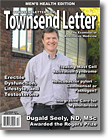|
Page 1, 2, 3
As a naturopath, who spends a lot of time in the gym and fitness realm, I am often asked health-related questions. Reflecting on some of these questions, I realized there is an underlying theme for many of the men who seek me out.
Recently, I had a question asked by an acquaintance who made it clear, he was uncomfortable asking. The short of it is, this guy is a lifter. He is fairly healthy, beyond healthy, compared to the average Westerner. He does mostly all the right things. Sure, he drinks a little and stresses a lot. But who doesn't, right?
He told me he has been fatigued, lacking motivation and drive for almost a year. He has slowly been gaining weight around the middle. Not enough that anyone else would notice, but he sees it. He has also starting to get soft around the chest. This is fairly common in men in their mid-thirties to forties, but not so common in a lifter. None of this bothered him too much, and then he told me about his erections. They are incomplete, unsustainable, and sometimes don't come at all. This was the part that is obviously the most upsetting because his tone became desperate.
I hear all of this, and I have two questions for him. First, are you on any type of anabolic steroid, or did you just get off of them? I ask this because he is a weight lifter, and steroid use is so common. A well-known symptom of anabolics is, when you come off of them, the body has difficulty picking back up its own production of testosterone. The second question is when did you last have your testosterone levels checked? He answers "no" to the first question and "never" to the second question. This tells me I am going to need to give him a crash course in both erections and testosterone.
 Townsend Letter provides a platform for those examining and reporting on functional and integrative medicine. Please support these independent voices. Townsend Letter provides a platform for those examining and reporting on functional and integrative medicine. Please support these independent voices. |
A Crash Course in Erections
Obviously, his major concern is the erections, but there is much more going on. Let me walk you through what I am thinking, as a naturopathic physician.
The male erection is a closely orchestrated event between the nervous system and blood flow into and out of the penis.
The brain registers a "sexually relevant" cue. This could be any number of things, and the stimulus response depends on the man. It may be cuddling up with his partner, seeing his partner walking across the room naked, maybe visual pictures or porn, while others may need direct penile stimulation. The point? The brain is where erections are made and they are often context dependent.
 Assuming the brain is adequately sensitized to a sexual stimulus, nerve impulses are sent to the penis. This triggers a host of biochemical events that involve chemicals like nitric oxide (NO) being released, which then trigger cellular cyclic GMP (cGMP), which opens the blood vessels in the penis allowing more blood to flow in. Assuming the brain is adequately sensitized to a sexual stimulus, nerve impulses are sent to the penis. This triggers a host of biochemical events that involve chemicals like nitric oxide (NO) being released, which then trigger cellular cyclic GMP (cGMP), which opens the blood vessels in the penis allowing more blood to flow in.
The penis is a pretty remarkable piece of physiological machinery. While blood flow is increased going in, a spongy layer of the penis, rich with capillaries, becomes engorged causing pressure to build up. This hydrostatic pressure causes the penis to inflate. This is all also contingent on a separate set of blood vessels that drain the penis. These vessels start to constrict under the increasing pressure and other biochemical events. The coordinated action of the incoming blood vessels, and the building pressure is what allows blood to rush in and stay in, creating an erection.
Where does testosterone get in on the action and contribute to this entire process? We will get to that in a second. First, I want to teach you a framework that will help you triage your own erection issues (or that of your partner). When you think of testosterone, libido, and erections, it is helpful to have a framework. The framework I use is the three Bs: brain, biochemistry, and blood flow.
The Brain
The sexual brain can be thought of as containing sexual stimulators and sexual repressors. Emily Nagowski, PhD, author of Come as You Are: The Surprising New Science that Will Transform Your Sex Life, calls these "accelerators and brakes." In order for sexual desire to occur and sexual arousal to engage, the accelerators need to be turned up while the brakes are turned down.
It kind of works like this: You are sitting on the couch working frantically to get a proposal done for work. You are stressed. Your partner sits down next to you, and starts rubbing on you. You register a "sexually relevant stimulus" in your brain. This hits the accelerators. But, before you can really get aroused, the brain checks in on the context. It says, "This is nice, but I have to get this stuff done." The stress you are under puts the brakes on.
The degree to which the stimulus can amplify the accelerators, and the stress holds on the brakes, will determine the quality of the erection response.
Many people get this all wrong. The brain is at work here, and it is not just an automatic stimulus response apparatus. There is much more going on. By the way, men, women have far more sensitive brakes compared to men. This is why foreplay and context are so much more important to their sexual arousal, desire, and function. It is also the same reason alcohol, or a first date, may result in a weak erection or a complete lack of erection for a guy, despite his strong desire. Every man, and likely most women, has experienced this phenomenon.
The brain is critical. Relaxation and adequate nerve stimulus to the penis is required. Women, it has nothing to do with you. And, guys, it is completely normal to occur on occasion.
To understand this brain effect better, think "Point and Shoot." The two branches of the nervous system are P, parasympathetic, and S, sympathetic. Parasympathetic is relaxing, and sympathetic is stimulating. The balance of the P and S is critical. To get an erection, you need adequate P, or parasympathetic outflow. Think P, for Point, to remember this. To ejaculate requires adequate sympathetic outflow. Think S, for Shoot, to remember this.
A man who ejaculates too quickly and/or has weak erections may be dealing with poor parasympathetic (relaxing) outflow. This may be due to being overworked, overwhelmed, alcohol, stress, mood, medications, or any condition that disrupts nerve signaling – the most common being diabetes.
A man who is unable to ejaculate or takes longer to ejaculate may be suffering from the opposite: Poor sympathetic outflow. This, too, can be caused by stress, overwork, overwhelm, mood medications, and diabetes. This also may be a sign of the use of Viagra or another PDE5 inhibitor. For younger men, who are not overweight, this is almost always a result of some type of stress effect or medication since most are not dealing with diabetes. My friend was an example. We could assume the brain piece of this was fine.
Another brain concern has to do with the command and control center of the metabolism. The hypothalamus is an area of the brain that receives signals from other hormones and coordinates other hormone-producing organs in the body. The hypothalamus registers all the signals from the environment (sight, sound, temperature, etc.) and signals from inside the body (exogenous hormones) then adjusts the metabolism as needed, much like a thermostat.
As it pertains to the testes, the hypothalamus releases gonadotropin releasing hormone (GnRH), which binds in the pituitary and triggers the release of luteinizing hormone (LH). LH then travels to the testicles, aiding sperm production (mostly the job of FSH), and turning up testosterone production.
If this hypothalamus-pituitary-gonad communication link is compromised, it can dramatically impact testicular function and testosterone. Testosterone inhibits feedback at the hypothalamus and can also be converted to estrogen via the enzyme aromatase. That estrogen plays a role in feedback to the pituitary, which is why SERMs (selective estrogen receptor modulators) like tamoxifen, are sometimes used in men.
The estrogen effect may come to be a major player here. We do not yet have proof, but many natural medicine practitioners, like myself, believe the sharp rise of low testosterone in young men may be connected with the estrogen saturation in our environment. Estrogen-like compounds are everywhere now. They are in our water, leach out of plastics, sprayed on our food as pesticides, and accumulate in the fat and milk of the animals we eat.
So, when we think "brain," we also want to be thinking hypothalamus. The other interesting thing here is that the hypothalamus and pituitary are also responsible for thyroid and adrenal function. These are so critical to metabolic function; they are referred to as HP-axis (hypothalamus-pituitary-thyroid axis (HPT), hypothalamus-pituitary-adrenal axis (HPA), and hypothalamus-pituitary-gonadal axis (HPG, i.e. testicles and ovaries). This will become important later.
This is why some therapies, like human chorionic gonadotropin (HCG), can be effective in multiple ways for men. It is also why low libido and low testosterone issues, coming from the brain, usually result in fatigue, sleep disruption, mood issues, weight gain, cold intolerance, etc. When the hypothalamus "takes a hit," it negatively impacts multiple downstream processes in the thyroid, adrenals, and gonads.
The Biochemistry
Given my friend is younger and fit, I am thinking his issue is biochemical, not brain or blood flow related. I have already covered some of the biochemistry of erection, but there is a ton more. Let's just stick with some of the more relevant material.
I already explained how the nerve signals transfer into biochemical signals, including signaling molecule cGMP and NO (nitric oxide). Let's cover this in a little more detail, as this is probably how testosterone gets involved in regulation of erection. When the brain sends nerve signals to the penis, NO is released and signals cGMP. This, then, dilates blood vessels and sets the erection cascade in motion with increased blood flow in and decreased blood flow out.
Cyclic guanosine monophosphate (cGMP) is broken down by an enzyme called phosphodiesterase 5 (PDE5). Since PDE5 degrades cGMP activity, if this enzyme is overactive, blood flow into the penis is slowed, and erection is either absent or incomplete.
This is how the erectile drugs Viagra, Cialis, Levitra, and others work. They each act as inhibitors to PDE5, prolonging action of cGMP activity, and therefore, allowing harder, longer lasting erections. Depending on the strength, their effects are short acting like Viagra (takes 30 min to kick-in and lasts 2-4 hours), or long acting like Cialis (takes a few hours to kick-in and lasts 18-36 hours). This may also be where low testosterone comes in.1 Testosterone treatment increases NO activity and may stimulate healthy promotion of erectile tissue. Testosterone may also play a role in PDE5 inhibition because adequate testosterone levels are required for these drugs to work.
The brain is also impacted by testosterone. All the mechanisms as to how testosterone promotes libido and sexual function are not completely understood, but one of the hallmarks of any hormone is its ability to impact many enzymes and other hormone receptors involved in multiple areas.
Testosterone is likely acting as a priming apparatus for the male sexual brain and penile function. Without this primer, the entire cascade is disrupted.
Page 1, 2, 3
|
![]()
![]()
![]()
![]()






